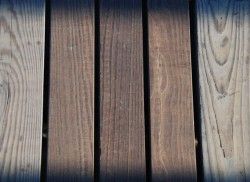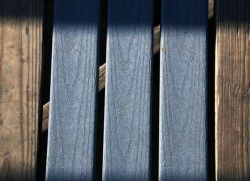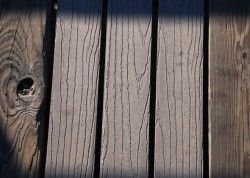Sheepshead Bay’s Historic Footbridge To Change, As DOT Alters Material Without Telling Community

Strolling over the Ocean Avenue footbridge’s wooden planks has been the quintessential Sheepshead Bay experience for 131 years, but a Department of Transportation initiative will soon see the familiar timber ripped out in favor of new materials – a decision they’ve made without community input.
For at least a month, the bridge, spanning the waters between Emmons Avenue and Manhattan Beach, has been a testing site for three materials expected to replace the tropical hardwood planks that make the walkway. But community leaders, organizations and activists are blasting the city agency behind the project for making such striking alterations without so much as a phone call to local stakeholders.
“They have never asked us,” said Community Board 15 Chairperson Theresa Scavo. “I know nothing about the wood they’re using. It looks like they’re just doing whatever. When Department of Transportation has pure control, this is what happens. There’s no notification. Nothing.”
Community Board 15 is not alone. Staffers at Assemblyman Steven Cymbrowitz’s office, located just across the street from the bridge, were similarly surprised when Sheepshead Bites informed them of the planned changes. As was City Councilman Michael Nelson’s staffers, located four blocks away. Bay Improvement Group, which works to preserve the history and character of Sheepshead Bay and has been pushing to landmark the bridge for years, was also in the dark.
“[Changing the bridge without community input] is another slap in the face,” said BIG President Steve Barrison. “It’s slap after slap and an insult and a knife in the back and a knife in the heart at the same time, and it’s like saying ‘Screw you! Screw you Sheepshead Bay! Screw you public! Screw you South Brooklyn! We know what’s best.'”
A spokesperson for the Department of Transportation offered the following statement about the changes:
“As part of the Mayor’s effort to reduce the use of tropical hardwoods, we are testing a variety of materials at the Ocean Avenue footbridge to determine how they perform in real world conditions.”
The Department of Transportation would not confirm the materials used, nor would they respond to inquiries about community outreach.
It’s not the first time the mayor’s initiative, launched in 2008, has stirred community outrage in Southern Brooklyn for its disrespect of history and community wishes. Coney Island-lovers have been blasting the city for years for pushing synthetic woods and concrete onto Riegelmann Boardwalk along Brighton Beach and Coney Island. Only after intense opposition did the city bend, holding public hearings and eventually compromising by limiting the concrete to a narrow strip down the center, synthetic woods on the side, and no changes at all to the boardwalk near the amusement area. The community viewed it as a loss – but better than an all-concrete boardwalk, as the city initially proposed. (The City Design Commission has delayed the changes for further study.)
Luckily for Sheepshead Bay’s residents, the city is not considering using concrete on the Ocean Avenue footbridge. In three separate locations spread out across the bridge, they appear to be testing two forms of synthetic lumber (one or both may be recycled) and Kebony-treated wood. All three materials have different shading than the wood currently in use, and the planks are cut shorter and narrower than the existing wood. [See sidebar for photos.]
Some worry that kind of aesthetic change could diminish the structure’s charm.
“It’s a historic bridge, it’s a wooden timber bridge, it’s a tremendous amount of history there,” said Barrison. “For the city of New York to come in and treat this with even more disrespect than they treated the boardwalk, which is a disgrace in itself, this one bridge crossing this one body of water, the last piece of original maritime history in all of the Sheepshead Bay waterfront, is disgraceful and insulting.”
Particularly galling to community leaders is that the changes are being made while the bridge is in sound condition. It was fully repaired last fall, with every one of the wooden planks torn out and replaced with fresh wood that was expected to last between 12 and 20 years.
“It’s only a little more than a year ago that the City spent a considerable amount of money replacing the decaying boards of this footbridge. Now, they decided to rip up the new boards,” said Assemblyman Cymbrowitz. “Couldn’t they have run this test on a bridge that was in need of repair?”
Scavo said replacing the freshly-installed wood is just another symptom of a city caring more about cents than sense.
“Do you think someone went there, stood there and looked at the condition of the wood? Since they did the repairs last time, I think they’ve been pretty good. So why would they get rid of them?” she asked. “The only answer I could think of is cost-cutting.”
Although the DOT would not respond to further inquiries from Sheepshead Bites, the city claimed during the Riegelmann Boardwalk controversies that the newer alternatives are not only intended to be environmentally friendly, but longer-lasting and less in need of costly maintenance.
Safety might be another concern, according to one local politician.
“Councilman Nelson, like everyone else, would like to preserve the historic nature of Sheepshead Bay as much as possible,” said Steve Zeltser, Councilman Nelson’s chief of staff. “But if the City is testing these new materials that prove to make the bridge safer for pedestrian use then that is something that we will need to explore.”
That’s all hogwash to Barrison. He said the safety of the existing bridge is not in question, and, in fact, the new materials may prove to be more dangerous – and costly.
“I would like to know the full extent of the study done on those woods and how it deals with bird droppings and how it deals with wetness from rain, ice, snow and sleet,” he said. “Is it more slippery? Manufactured wood tends to accumulate ice and snow and freeze faster than wood. The balance of the liability issues could end up costing the city a lot more money than they’re saving.”
Even if it were cheaper and more environmentally friendly, the impact caused by the tiny bridge would need to be weighed against its historical value. Barrison said he sides with history.
“No matter how bad the economy is or what is going on in the environment, no one can tell me that this one bridge being maintained in its original style and material so long as it’s available on this earth should not continue,” he said. “There’s no logical reason to not do that. The idea of saving is silly because even the experiments cost money.”
But the historical value of the bridge is itself a point of contention. In some ways, the structural change is just the latest chapter of a constantly evolving Sheepshead Bay signature.
“While there’s been a bridge across the Bay for 131 years, the structure currently spanning the waters is really only 94 years old,” said local historian Joseph Ditta.
Originally built in 1880 by railroad tycoon Austin Corbin, the bridge was torn down that same year when the notoriously anti-Semitic developer of Manhattan Beach’s resort hotels changed his mind, deciding it was letting in too many “undesirables.” It was rebuilt by locals and torn down by Corbin several more times until, in 1881, the government declared it a public highway and the Supreme Court issued an injunction against tearing it down. The city deconstructed it in 1917 to move it from its original location on Ocean Avenue to East 19th Street. Over the years, the lampposts have changed, and there have been numerous modifications made to comply with various laws and regulations. Most recently, the Manhattan Beach end was significantly raised in 2008, changing its size and shape, after the bulkhead beneath it collapsed.
So, to some history buffs like Ditta, change is very much in keeping with the bridge’s history. What’s more important is that the change is tasteful.
“Hopefully the City will go with something in keeping with the simplicity and rusticity of the bridge. Concrete slabs would be awful,” he said.







